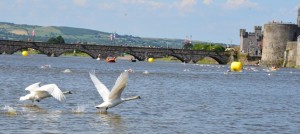Thomond Swim History
Posted on 25, June 2013
in Category Club News, Thomond Swim
Thomond Swim (Thomond is the Gaelic for North Munster)
The Thomond Swim starts from the slipway at St Michael’s Boat Club on the north shore of the river Shannon and then the route takes the swimmers along by O’Callaghan Strand under Sarsfield Bridge along by the side of Clancy Strand past the Old Barracks (O’Callaghan and Clancy were two former Mayors of Limerick who were executed by the Black and Tans during the War of Independence). The swim then passes where the Curragower Salmon Fishermen used to moor their angling cots and dry their nets. Some of their cottages are still occupied by the old families. When the tide is full out it is worthwhile to come back to see the impressive waterfalls here.
Then the swim carries on to the location of the Treaty Stone, upon which the famous Treaty of Limerick was signed, between the Jacobite’s and the Williamite’s in 1691. The Treaty Stone is the logo symbol for Limerick Masters Club and features on the race swim hat and in many official representative crests associated with the county. It was immediately in the aftermath of the signing the Treaty and as an accepted part of the Treaty that the many of the Irish Jacobite Army left for France and are referred to as the original “Irish Wild Geese”. The swim then crosses the Shannon just below Thomond Bridge to the 1000 year old King Johns Castle which is built on King Johns Island and referred to by locals as simply the “Island”. Michael Hogan The Bard of Thomond whose statue is at the Castle entrance wrote many a verse about this part of the Shannon and Thomond Bridge. In more recent times Maureen Sparling who has strong links with Limerick Swimming has also written some beautiful poetry about the area.
In 1690 Thomond Bridge was where Patrick Sarsfield led the Irish Cavalry out under cover of darkness to begin the long journey to successfully attack at Ballyneety and render useless the big siege guns which the Williamites had on route to blast and bring down the Walls of Limerick. The Bridge was also was the scene of bitter fighting which saw 300 Irish Infantry men killed in defence of the city when the French Officer in the Castle prematurely closed the castle gate leaving them outside the walls.
When swimming towards the castle sometimes the setting sun illuminates the walls with a beautiful light and swimmers have been seen to stop and admire the view. However our advice is to keep the head down as there is still a lot of swimming to be done and this part of the swim can be challenging.
The Swim then continues down the side of the Island under the Castle walls and then past the 1000 year old St Marys Cathedral, the more modern Limerick Civic Offices and The Court House. The swim then takes you across the mouth of the Abbey River referred to by local fishermen as Hells Gate. However as we will be swimming at high tide we will have an easy crossing. The swim then continues past the Old Customs House (now the Hunt Museum and then past the Revenue Commissioners. In recent races it has been observed that many swimmers for some reason or other achieve their fastest times during this part of the swim when passing the Court House, Customs and Revenue buildings. However some strong swimming will still be required downstream to bring the swimmers past both the Shannon and Limerick Boat Clubs before taking a sharp left into the finish the race near the Sin Bin on Howleys Quay.
By Paul Kearney


0 Comments